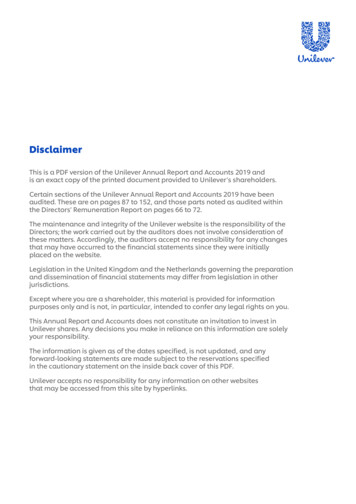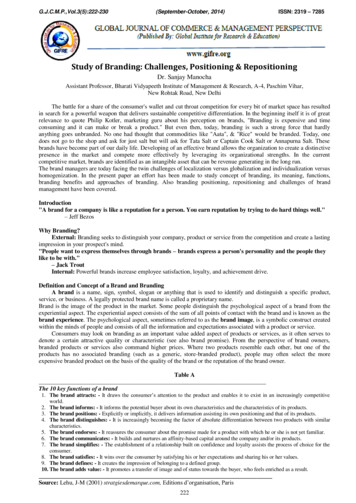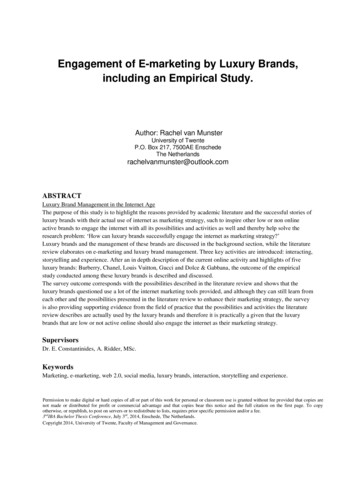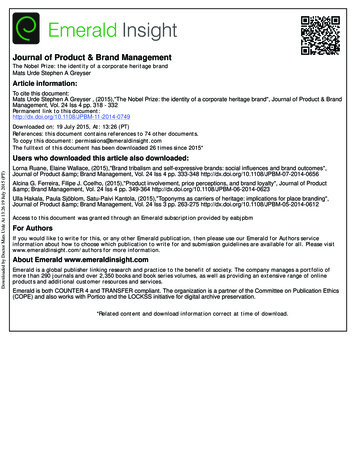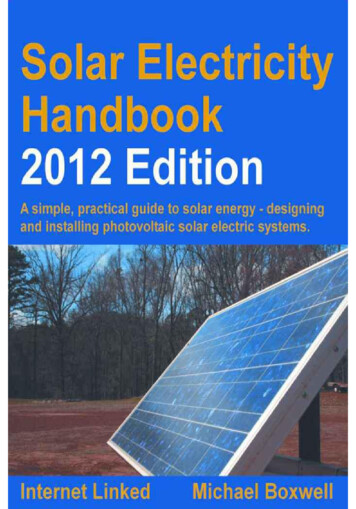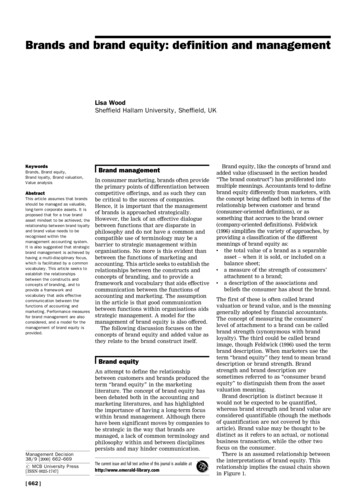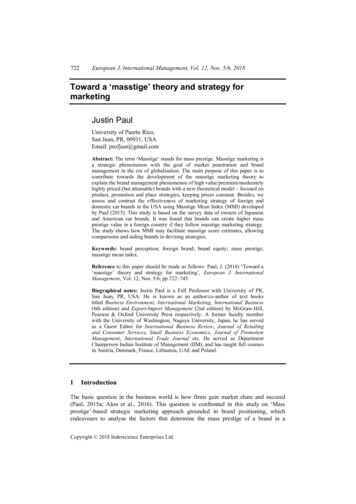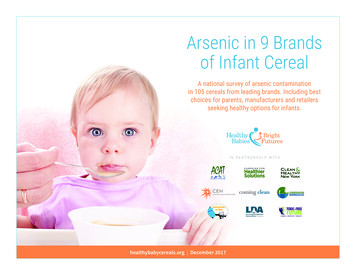
Transcription
Arsenic in 9 Brandsof Infant CerealA national survey of arsenic contaminationin 105 cereals from leading brands. Including bestchoices for parents, manufacturers and retailersseeking healthy options for infants.I N PA RT N E R S H I P W IT HCONSERVATIONMINNESOTAhealthybabycereals.org December 2017
ACKNOWLEDGEMENTSTABLE OF CONTENTSAuthor: Jane Houlihan, MSCE, National Director ofScience and Health, Healthy Babies Bright FuturesEXECUTIVE SUMMARY. 1Healthy Babies Bright Futures (HBBF) would like to thankthe following people and organizations for their support:A network of groups and individuals around the countrymade this study possible by purchasing cereals at theirlocal stores: Ecology Center, Clean and Healthy New York,Getting Ready for Baby, Alaska Community Action onToxics, Texas Environmental Justice Advocacy Services(T.E.J.A.S.), Campaign for Healthier Solutions, Organizacionen California de Lideres Campesinas, Inc., Center forEnvironmental Health, Coming Clean, Learning DisabilitiesAssociation of America, Conservation Minnesota, BarakaCommunity Wellness, and Toxic-Free Future. Thanks toSonya Lunder of Environmental Working Group for logisticssupport, and Alec Litrel for Atlanta-based cereal purchases.We are grateful for the guidance and review providedby Dr. Philip Landrigan (Mt. Sinai School of Medicine),Dr. Margaret Karagas (Dartmouth), and Bruce Lanphear(Simon Fraser University). Our thanks also go to JoseBravo with the Campaign for Healthier Solutions and SamSchlesinger, for help creating the Spanish language versionof this study.The study was made possible by grants fromForsythia Foundation, Passport Foundation, andThe John Merck Fund.Special thanks to HBBF’s National DIrector CharlotteBrody, RN, for guidance throughout this study. Theopinions expressed in this report are those of HBBF anddo not necessarily reflect the views of the supporters andreviewers listed above. HBBF is responsible for any errorsof fact or interpretation contained in this report.Health Cost: Diminished Intelligence for Children.2Rice Cereal: Infants’ Top Source of Arsenic.2Recommendations.4Cereal Companies.4FDA .4Parents.4STUDY METHODOLOGY AND FINDINGS. . 5HEALTH RISKS – THE SCIENTIFIC EVIDENCE. 6Arsenic and IQ Loss – 13 Studies, 7 Countries.7Arsenic’s Irreversible Harm.7The Less Common Form of Arsenic in Infant Cereal: Safety in Question.7Safety Standards for Arsenic in Food.7REFERENCES. 8APPENDIX A: LABORATORY TEST RESULTS. 9APPENDIX B: LABORATORY ANALYSIS – SUMMARY OF METHODS. . .14Report design: Winking Fish December 2017 by Healthy Babies Bright Futuresand New Venture Fund. All rights reserved.A r s e n i c i n 9 B ra n d s o f I n f a n t C e r e a l h e a l t h y b a b y c e r e a l s . o r gII
Arsenic in 9 brands of infant rice cerealOur findings show the urgency for action by parents, cereal makers, and FDA to get high-arseniccereals off store shelves and out of infants’ dietsEXECUTIVE SUMMARYIt’s no secret that infants ingest traces of arsenic with everybite of rice cereal. Widespread reporting on the problembegan five years ago, when tests by Consumer Reportsfound arsenic in rice and rice-based foods, includinginfant rice cereal. Rice readily absorbs arsenic from theenvironment, about 10 times more of it than other grains.Widespread concern and public pressure – combined withgrowing science on arsenic’s toxicity at low levels – shouldhave spurred the U.S. Food and Drug Administration eststests foundfound sixin ininfantinfantricecerealthaninothertypesinfantrice cereal than in other types of infant ofcereal,includingoatmealoatmealand multi-graincereal,includingand multi-grainAverage arsenic level (inorganic, ppb)85 ppb of Arsenic80Infant ricecerealand the cereal industry to take high-arsenic cereals off storeshelves. It hasn’t happened.FDA is, in a word, stalled. More than a year after issuing its2016 draft guidance to cereal makers – the culmination offour years of assessment – FDA is falling short of protectinginfants. It has not set a final limit for arsenic in rice cereal. Ithas failed to finalize the proposed cap in its draft guidance,even though there is no known safe level of arsenicexposure.Arsenic is strictly regulated in drinking water, but is legalin any amount in infant rice cereal. It is a potent humancarcinogen and a neurotoxin shown to permanently reducechildren’s IQ.A new study led by Healthy Babies Bright Futures (HBBF)helps parents navigate the gaps. HBBF’s tests of 105 infantcereals show that non-rice and multi-grain varieties ongrocery shelves nationwide – including oatmeal, corn,barley, quinoa, and others – contain 84 percent less arsenicthan leading brands of infant rice cereal, on average. Thesealternate cereals include reliable and affordable choices forparents seeking to reduce infants’ exposures to arsenic.We tested infant cereal made by Gerber, Earth’s Best, BeechNut, Nestlé, and five other brands. All but one of the 42containers of infant rice cereal we tested had more arsenicthan any of the 63 other cereals included in our study.60402014 ppb of ArsenicOther infantcereals0Rice and brown riceHBBF’s tests are the first published results for arsenicin infant cereals that are made from some increasinglyavailable alternate grains – including gluten-free, sprouted,and nutritious “superfood” grains. We tested cereals madefrom oats, corn, barley, quinoa, wheat, amaranth, millet,sorghum, flax, buckwheat, and rye.Multi-grain, oatmeal, wheat,barley, quinoa, buckwheatArsenic in 105 store-bought infant cerealsA r s e n i c i n 9 B ra n d s o f I n f a n t C e r e a l h e a l t h y b a b y c e r e a l s . o r g1HOW TO LOWER YOUR CHILD’SARSENIC EXPOSUREChoose these infant cereals instead of rice cereal: oatmeal,mixed grain, quinoa, barley, buckwheat, and wheat. Ourtests found low arsenic levels in all brands tested.Cost-saving tip: Oatmeal and multi-grain infant cereals arejust as affordable as rice cereal.Avoid rice snacks. They have high arsenic levels, too.Does your family eat rice?Cook rice in extra waterthat you pour off beforeeating to reduce arsenic.For the lowest levels,buy basmati rice grownin California, India, andPakistan. Better yet, tryother grains, like quinoaand farro.Our study uncovered some good news. Our results suggestthat cereal makers have taken steps to limit arsenic. Wefound 85 ppb of arsenic, on average, in rice cereals testedin 2016 and 2017, versus the 103 ppb average level FDAfound in 2013 and 2014. Still, rice cereals contain too mucharsenic. Among expected health impacts from arsenic in ricecereal are increased cancer risk and harm to neurologicaldevelopment. Our tests show that rice cereals containconsistently higher amounts of arsenic – six times higher onaverage – than mixed grain and non-rice cereals.
HEALTH COST:DIMINISHED INTELLIGENCE FOR CHILDRENHBBF commissioned a new economic analysisto accompany our laboratory tests. It includes acomprehensive review and new analysis of IQ lossattributed to arsenic in infant rice cereal and other ricebased foods.The findings underscore the urgency for action by cerealmakers and FDA to get high-arsenic cereals off storeshelves. The research team at Abt Associates, a nationallyrecognized toxicology and economic research group,estimates that arsenic in infant rice cereal and other ricebased foods accounts for an estimated loss of up to 9.2million IQ points among U.S. children ages 0-6. This harmcosts the country an estimated 12-18 billion annually inlost wages, the result of IQ being diminished across theworkforce from ubiquitous, early-life exposure to arsenic inrice (Abt 2017).Arsenic is known to cause lung, bladder, and skin cancer,but arsenic in infant rice cereal also poses a threat tothe developing brain. In the peer-reviewed scientificliterature, at least 13 studies link arsenic to IQ loss andother neurodevelopmental impacts for children exposedin utero or during the first few years of life (RodriguezBarranco 2013).9Widespread exposure to arsenic in infant rice cereal, likechildren’s exposures to lead, shifts the population-wideIQ curve down. It nudges more children into specialeducation, and ratchets down the IQ of the most creativeand intellectually gifted children. For an individual child,the harm appears to be permanent (Wasserman 2007 and2016, Hamadani 2011).promoting arsenic additives (now mostly banned) that wereroutinely fed to the birds. Rice is also often cultivated inflooded fields; under these conditions, arsenic is prevalentin its most toxic (trivalent) form, the form most easilyaccumulated by rice.RICE CEREAL:INFANTS’ TOP SOURCE OF ARSENICArsenic is ubiquitous in soil and water, and contaminates manyfoods. But infant rice cereal is the major source of arsenicfor infants, accounting for 55 percent of their total dietaryexposure (Shibata 2016). Sixty-four percent of infants fourto six months old have been served rice cereal. Eightypercent eat it by their first birthday. The amount of arsenicis considerable: infants who eat rice cereal have 3.3 timesmore arsenic in their urine than infants with a rice-free diet(Karagas 2016).Rice, in contrast with other grains, readily absorbs andconcentrates arsenic from soil and water. It concentratesabout 10 times more arsenic than other grains used ininfant cereals. Rice is also grown where arsenic is abundant,magnifying the problem. Rice in the southern U.S. is oftenplanted in old cotton fields, where (now banned) arsenicpesticides were sprayed for decades. Fertilizer contributedInfantriceit includedcerealchickenconsistentlyin arsenic:aswell, whenwaste laced higherwith growthFortunately, many lower-arsenic cereals are affordable. ForAll but one rice cereal we tested - 41 containers altogether - hadexample,more retailers offer Gerber and Earth's Best infant oatmealarsenic than any of the 63 non-rice cereals tested.and multi-grain cereals for the same price as their rice cereal.Infant rice cereal consistentlyhigherinarsenic:Arsenic in each cereal tested, ppbAverage arsenic, ppbqAll but one rice cereal we tested - 41 containers altogether Arsenicin 105infantcereals cereals tested.had more arsenicthanstore-boughtany of the 63 non-riceand multi-grainArsenic in 105 store-bought infant cereals9.2millionIQ points lostchildren 0-6 years oldLO ST L I FETI ME EA R NI NG S 12-18 billionannual cost for the USSOURCE: ABT 20179q48Buckwheat 8Average arsenic, ppbq7Arsenic in rice: The impact to children'slearning ability and the economyWith so many factors boosting arsenic uptake in rice, it’s nosurprise that infant rice cereal contains high levels.7Arsenic in each cereal tested, ppbBarleyq106Quinoa 6q135Oatmeal 5q174q203Wheat4Multi-grain3q732Rice 2q9610720406080100120Arsenic level (inorganic, ppb)Brown rice 1140A r s e n i c i n 9 B ra n d s o f I n f a n t C e r e a l h e a l t h y b a b y c e r e a l s . o r g2DRAFT Healthy Babies Bright Futures Houlihan 11.13.17160220240
INFANT CEREALS PURCHASED FOR THE STUDY: BRANDS, GRAINS, AND STORESWe selected 105 individual containers of 45 different cereals for testing, sold under nine brand names and made from 13 grains.Testing was performed at Brooks Applied Labs in Bothell, Washington. Multi-grain and non-rice cereals had far less arsenic than the rice cereals we tested.945cereal brands13unique 14 metropolitan areasand 15 retail chains wherecereal were purchased: supermarkets dollar stores baby ILLETQUINOAFLAXBARLEYDetroitAlbanyPartner: Ecology CenterPartner: Clean &Healthy New YorkMinneapolisPartner: Alaska CommunityAction on ToxicsRICE ANDBROWN RICEPortland MEPartner: Learning DisabilitiesAssociation of AmericaPartner: ConservationMinnesotaSeattleBostonPartner: Toxic-Free FuturePartner: BarakaCommunity WellnessOaklandPartner: Center forEnvironmental HealthWashington DCPartner: Healthy BabiesBright Futures superstoresSan DiegoPartner: Campaign for Healthier Solutionsand Organizacion en California de LideresCampesinas, Inc.Charlottesville VAPartner: Healthy BabiesBright FuturesBoulderPartner: Citizen scientistHoustonPartner: Texas Environmental JusticeAdvocacy Services (T.E.J.A.S.)Online retailersA r s e n i c i n 9 B ra n d s o f I n f a n t C e r e a l h e a l t h y b a b y c e r e a l s . o r g3AtlantaPartner: Citizen scientist
RECOMMENDATIONSCereal CompaniesFDAOur research shows that cereal makers need to takeimmediate steps to reduce arsenic in their cereals. Thisaction is especially needed to protect infants who rely oncereal as a staple food.FDA should act immediately to set an enforceable, healthbased limit for arsenic in infant rice cereal and other ricebased foods. The limit should protect infants from bothcancer and neurological harm.Solutions suggested by FDA and other experts includesourcing rice from fields with lower arsenic levels in soil,growing it with natural soil additives that reduce arsenicuptake by the roots, growing rice strains less prone toarsenic uptake, preparing rice with excess water that ispoured off, and blending it with lower arsenic grains inmulti-grain products.In setting its 2016 proposed action level, the agency didnot consider IQ loss or other forms of neurological impact,allowed cancer risks far outside of protective limits, andfailed to account for children who have unusually highexposures to arsenic in rice (HBBF 2016).We found no evidence to suggest that any brand hasreduced arsenic levels in rice cereal to amounts comparableto those found in other types of cereal, despite at least fiveyears of significant public attention to the issue that hasincluded widespread consumer alerts and a proposed federalaction level (Consumer Reports 2012 and 2014, FDA 2016c).Our study suggests that rice cereal makers can achieve afar lower, more health-protective limit than FDA’s currentproposal. Our tests found arsenic levels in rice cereal aslow as one-fifth the amount FDA has proposed as its actionlevel. Rapid action by FDA to set a protective level willprotect children from arsenic-contaminated rice.ParentsParents who include infant rice cereal in their baby’s dietcan immediately lower their child’s arsenic exposuressimply by switching to oatmeal, multi-grain, and othernon-rice cereals. Many of these alternate cereals alsocontain added iron; in an infant’s diet, they can replaceiron otherwise supplied by fortified rice cereal. Some areas affordable as rice cereal, including common brands ofoatmeal and multi-grain cereals.We recommend that parents avoid infant rice cereal. Nonrice and multi-grain alternatives have consistently lowerarsenic contamination, and are a healthier choice.A r s e n i c i n 9 B ra n d s o f I n f a n t C e r e a l h e a l t h y b a b y c e r e a l s . o r g4
STUDY METHODOLOGYAND FINDINGSA cup of prepared infant rice cereal has more thandouble the amount of arsenic allowed in a cup of water:HBBF and a national, volunteer network of 11 other nonprofit organizations purchased infant cereals from storesin 14 metropolitan areas across the country. We purchasedcereals from 15 retail chains - supermarkets, dollar stores,baby stores, superstores and two online-only retailers.With its legal limit of 10 parts per billion for arsenic in drinkingwater, the U.S. Environmental Protection Agency (EPA) allows2.4 micrograms of the toxin in every cup (8 ounces) of water. Acup of infant rice cereal contains more than twice that amount– 5.0 micrograms of arsenic, on average, based on FDA's cerealtests (FDA 2016c).We commissioned a nationally recognized laboratory withexpertise in arsenic analysis, Brooks Applied Labs (BAL)near Seattle Washington (http://brooksapplied.com/), totest for arsenic in the 105 cereal containers included in thisstudy. Laboratory analyses and quality control proceduresare described in Appendix B. Our analysis of test resultsshowed:The 10 ppb regulatory limit for arsenic in water isn’t perfectlysafe: It is set to reduce cancer risk, not neurological harm. Itallows a 400 to 7,000 times higher risk than EPA’s de minimislevels (Nachman and Ginsberg 2017), and is twice the 5 ppblimit originally proposed by EPA and adopted in New Jersey. Acup of rice cereal has over 4 times the amount that is legal inan 8-ounce glass of water in New Jersey.All brands and types of infant rice cereal contained morearsenic than non-rice and multi-grain cereals.Multi-graininfantcerealswithrice containthanMulti-graininfantcerealswith ricecontainless thanlessonethirdas much asarsenicasarsenicinfant riceone-thirdmuchas cereal.infant rice cereal.100Infant Rice Cereal – Six times more arsenic than othercereals tested, on average. Six brands of infant rice cerealwere tested: Gerber, Beech-Nut, BioKinetics, HappyBABY,Earth’s Best, and Healthy Times.Other Infant Cereals – Lower levels or no detectablearsenic. Nine brands of non-rice and multi-grain cerealswere tested: All six brands listed above, plus NurturMe,Little Ducks, and Nestlé.85 ppb80Average arsenic level (inorganic, ppb)We found more arsenic in all but one of the 42 rice cerealstested than in any of the 63 containers of non-rice andmulti-grain infant cereals included in our study. Arseniclevels in infant rice cereal averaged six times higherthan in oatmeal, multi-grain, quinoa and other non-riceinfant cereals. Test results, including results by brand, areincluded in Appendix A.Infantricecereal604023 ppb2013 ppbOatmeal017 ppbMultigrain,no riceMultigrainwithriceArsenic in store-bought infant cerealsin HBBF's new studyA r s e n i c i n 9 B ra n d s o f I n f a n t C e r e a l h e a l t h y b a b y c e r e a l s . o r g51 cup of cereal versus 8 ounces of water.On average, rice cereal contains more than twicethe legal limit for arsenicin drinking water.2.4 MICROGRAMSOF ARSENICIN EVERY8 OUNCES WATER5.0 MICROGRAMSOF ARSENIC(ON AVERAGE)IN A CUP OFINFANT RICECEREALMulti-grain cereals, even those that contain rice, havefar less arsenic than infant rice cereal, and are goodchoices for parents:Shoppers participating in this study found oatmeal andmulti-grain (with rice as an ingredient) to be the mostwidely available alternatives to infant rice cereal. In ourtests, both were far lower in arsenic than infant rice cereal,for 41 of the 42 rice cereal containers we tested. Multi-graincereals without rice had even less arsenic, just one-fifth theamounts found in infant rice cereal, but were less commonin stores.
HEALTH RISKS –THE SCIENTIFIC EVIDENCEArsenic is a versatile poison, famously deadly at high dosesbut also harmful in trace amounts. Its rap sheet earns it atop spot on health agencies’ lists of threats posed by thechemicals commonly found in Americans’ bodies.People exposed regularly to low doses of arsenic are morelikely to suffer from cardiovascular disease, diabetes,respiratory problems, infections, and cancer, primarilyskin, bladder and lung cancer. Adults and children exposedregularly can develop serious health conditions as arsenicblocks natural tumor-fighting hormones, interferes withimmune cells, damages lung cells, and inflames heart cells.Among health agencies that classify it as a substance knownto cause cancer in humans are the U.S. EnvironmentalProtection Agency, the National Toxicology Program, andthe International Agency for Research on Cancer.Some infants face far higher risks than the average infant:Arsenic in infant rice cereal and other rice-based foodsposes a uniquely elevated risk for some children:Rice cereal and other rice-based foods are not infants’only source of arsenic. Arsenic widely contaminates food,drinking water, playgrounds and backyards from its longtime use as a pesticide and outdoor wood preservative, andits release from mining and industrial operations. In someparts of the U.S. it occurs naturally at elevated levels in bothsoil and groundwater. Children with celiac disease often eat rice in place ofgluten-containing grains. They ingest 14 times morearsenic than other children, on average (Munera-Picazo2014, Abt 2017). Thirty percent of infants are given solid food before theage of four months, even though it is recommended thatinfants consume only breast milk in the first six months oflife (Briefel 2004). Because their bodies are so small, theyface higher risks than older infants from toxins like arsenic.As a result, arsenic is a common contaminant in drinkingwater and many different foods. Children who drink waternaturally high in arsenic face elevated risk. EPA estimatedin 2000 that 36 million Americans drank water containingarsenic at or above the health-based limit proposed bypublic health advocates (3 parts per billion, NRDC 2017). Infants eat many different foods that contain arsenic, notjust infant rice cereal. Twenty-four percent of infants ages9-12 months drink apple juice, and 43 percent eat noninfant cereals that contain arsenic, for example. The healthrisks from arsenic in these foods add up (Siega-Riz 2010).Arsenic is also commonly found in children: the federalCenters for Disease Control and Prevention (CDC) also findsit in the urine of 86 percent of children tested, in nationalbiomonitoring surveys (deCastro 2014). National diet surveys show that Hispanic infants andtoddlers are 2.5 times more likely to eat rice on a given daythan other children (EPA 2008). Asian Americans eat nearly10 times more rice than the national average (Potera 2007).Of the many possible sources, however, infant rice cerealranks first for most infants, according to national dietarysurveys. It accounts for 55 percent of the total inorganicarsenic (the more toxic form of arsenic) infants ingest, onaverage (Shibata 2016).A r s e n i c i n 9 B ra n d s o f I n f a n t C e r e a l h e a l t h y b a b y c e r e a l s . o r g6New studies of arsenic’s wide-ranging toxicity are publishedevery year. Among them are studies finding 1.5-foldhigher odds of skin cancer (squamous cell carcinoma)among people who eat rice versus those who don’t, andresearch showing higher risks for long-lasting respiratoryproblems like wheezing – including breathing problemsthat need prescription medication – among babies whosemothers were exposed to higher amounts of arsenic duringpregnancy (Gossai 2006, Farzan 2016).But arsenic also targets the developing brain. Its ability toerode IQ in children make its presence in infant rice cerealuniquely risky. Infant rice cereal is a staple in children’sdiets, is high in arsenic, and is eaten daily at a time in lifewhen the brain is intensely sensitive to chemical insult. Thiscombination is a perfect storm of risk for babies.
ARSENIC AND IQ LOSS – 13 STUDIES, 7 COUNTRIESAt least 13 studies link arsenic to IQ loss and otherneurodevelopmental impacts for children exposed inutero or during the first few years of life. They cover sevencountries, including the U.S. Leading experts now classifyarsenic as a substance known to cause neurological harmduring development (Grandjean and Landrigan, 2006 and2014). Multiple research teams and agencies have assessedits impact on IQ among children exposed to it through foodand water (Rodríguez-Barranco 2013, Tsuji 2015, CalEPA2008, Mass DEP 2011, Abt 2017).Among evidence supporting arsenic’s ability to harmthe brain is a 2014 assessment of nearly 300 third to fifthgraders in Maine, finding an average loss of 5-6 IQ pointsamong those who drank well water contaminated witharsenic at or above 5 parts per billion. This level is commonin some parts of the U.S., and is lower than the legal limitin public water supplies (10 parts per billion) (Wasserman2014).A new analysis by Abt Associates estimates a loss of 9.2million IQ points among children ages 0-6, from arsenic ininfant rice cereal and other rice-based foods (Abt 2017). Thisestimate is grounded in analyses from six research groupsand health agencies, each of which developed or applied amathematical curve (a “concentrationresponse function”) to definethe relationship betweenarsenic exposure and IQloss for a child (Hamadani2011, Tsuji 2015, CalEPA2008, MassDEP 2011,Wasserman 2004,Wasserman 2007).All but one of thesestudies are free offinancial conflictof interest.The study with a conflict is funded in part by a coalition ofindustries, manufacturers, and agricultural producers withinterests in the regulation of arsenic pollution (Tsuji 2015).Its methods yield an estimated to an estimated IQ loss atleast 16-fold lower than any of the estimates derived fromthe independent studies.* Results from all independentstudies correspond to millions of IQ points lost amongchildren ages 0-6 who eat infant rice cereal and other ricebased foods. Estimates highlighted in this study are in themid-range of the values derived from all six sources.ARSENIC’S IRREVERSIBLE HARMStudies find lasting impacts when children are exposedto arsenic early in life, including persistent IQ deficits inchildren two years after their polluted drinking water wasreplaced, cognitive deficits among school-age childrenexposed early in life, and neurological problems in adultswho were exposed to arsenic-poisoned milk as infants(Wasserman 2007 and 2015, Hamadani 2011, Tanaka 2010).There is no evidence that the harm caused by arsenic isreversible.THE LESS COMMON FORM OF ARSENIC IN INFANTCEREAL: SAFETY IN QUESTIONOur study focuses on inorganic arsenic, the form of arsenicthat is best studied, widely recognized to be toxic, anddominant in infant rice cereal. But like other studies, ourtests found another form of arsenic as well. On average,39 percent of the total arsenic in infant rice cereal was theorganic form of arsenic. While this form is considered lesstoxic than inorganic arsenic, there is little information on itssafety early in life, when the body and brain are developing.Organic arsenic is found in many foods commonly eaten byyoung children and pregnant women, including rice. It iseasily transferred from mother to fetus across the placenta,and it crosses the blood-brain barrier in infants (EFSA 2009,Abt 2017). Further study of the safety of organic arsenicexposure during development is needed.*Abt (2017) applies Tsuji’s 2015 methods for estimating the arsenic-IQrelationship in scenarios labeled “Hamadani et al. (2011) Linear."A r s e n i c i n 9 B ra n d s o f I n f a n t C e r e a l h e a l t h y b a b y c e r e a l s . o r g7SAFETY STANDARDSFOR ARSENIC IN FOODArsenic is on the EPA’s short list of chemicals classified asknown human carcinogens. It causes lung, bladder, and skincancer, among other forms. In 2001 the agency slashed thelegal limit for arsenic in drinking water, from 50 to 10 partsper billion. A year later, under pressure from the public andEPA, the outdoor wood industry announced a phase out ofwood treated with an arsenic pesticide, used in nearly alloutdoor wooden decks and playsets nationwide. With twomajor sources of arsenic in children’s lives reduced, FDA hadonly to set limits for arsenic in food to tackle the remainingmajor exposure source. It has yet to do so.Food safety guidelines in the U.S. include some provisionsfor arsenic. Because arsenic has been used in certainveterinary drugs, the federal government set maximumpermissible levels of arsenic in eggs, uncooked edibletissues of chickens and turkeys, and some uncooked ediblebyproducts of swine. But currently, there is no enforceablelimit for arsenic in rice or infant rice cereal (Shibata 2016).In 2016 FDA published draft guidelines for industry thatincluded an action level of 100 ppb for arsenic in infantrice cereal (FDA 2016c). This matches the standard setfor all rice-based foods in the EU. But neither the FDAnor regulators in the EU established this limit based on arigorous health assessment. And if FDA finalizes its actionlevel, it will serve only as guidance to the infant cerealindustry, not as a standard that FDA is required to enforce.Instead, FDA can choose whether or not to enforce an actionlevel, at its own discretion.FDA noted that the proposed action level could be metthrough “the use of current good manufacturing practice.”In effect, it set its action level based on what it believes theindustry can easily achieve, not on what would adequatelyprotect children’s health.“Gold standards” for health protection can include, forexample, limits that hold cancer risk to no more than oneadditional cancer in a population of one million (e.g., WHO2001). Arsenic in rice outstrips that risk by 40 times: onein 25,000 people will develop lung or bladder cancer from
exposures to arsenic in rice-containing foods, according toFDA’s estimates (FDA 2016a).An economic analysis by Abt A
based foods. The findings underscore the urgency for action by cereal makers and FDA to get high-arsenic cereals off store shelves. The research team at Abt Associates, a nationally recognized toxicology and economic research group, estimates that arsenic in infant rice cereal and other rice-based foods accounts for an estimated loss of up to 9.2
